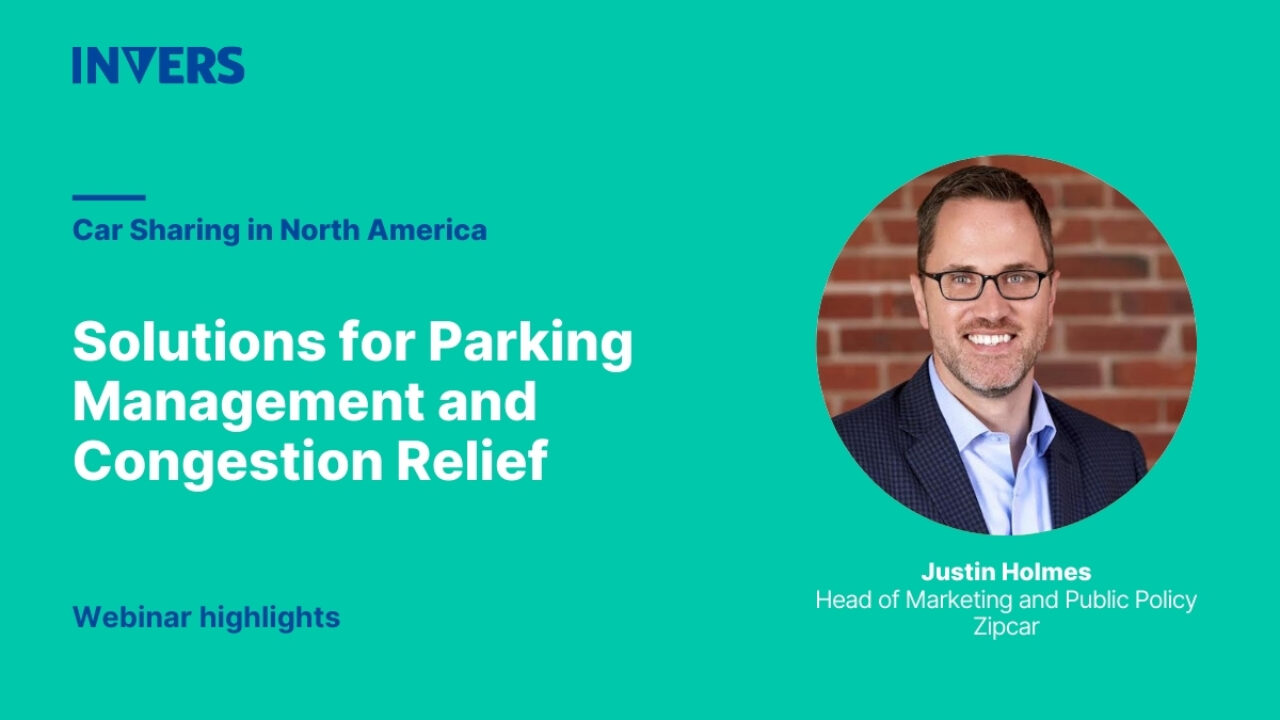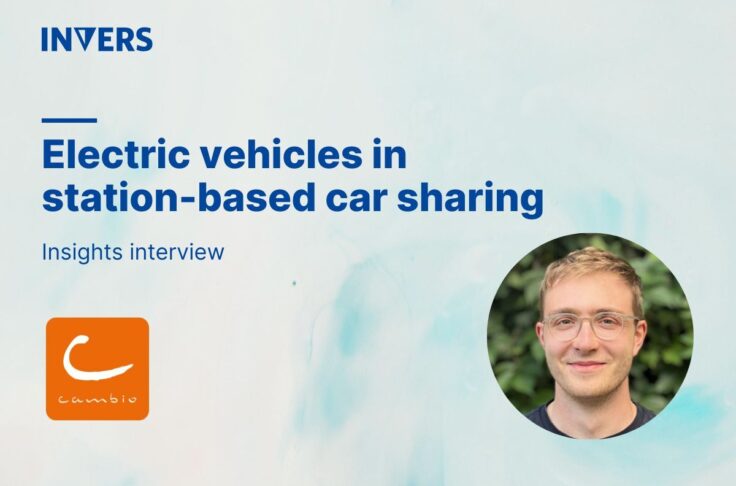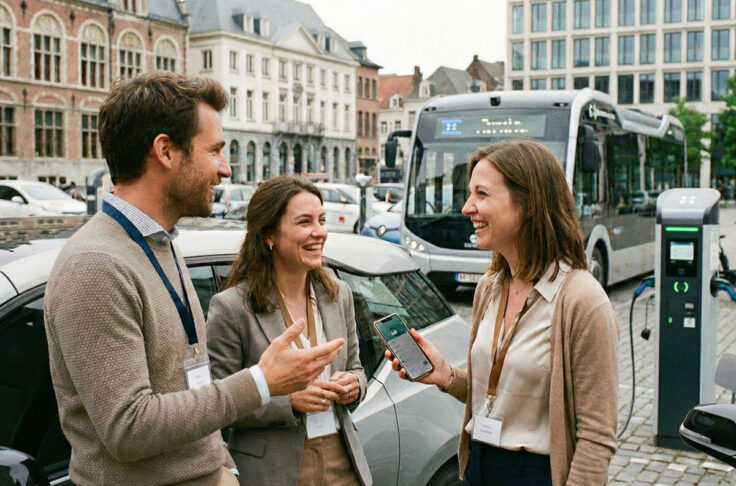7 Car Sharing Parking Solutions for Operators

One of the primary causes of car sharing operations leaving a city is high parking prices, says a 2020 study by the Carsharing Association and movmi. Access to parking is critical for car sharing. However, with the right parking strategies, this challenge can be turned into a competitive advantage.
7 actionable parking strategies and solutions:
- Collaborate with local authorities for designated parking spaces
- Partner with property developers to offer vehicle sharing services
- Don’t rule out university partnerships
- Integrate with parking-sharing platforms
- Alternatives to “Free Parking”
- Use technology for real-time parking management
- Make your parking plan future-proof
Understanding car sharing’s parking needs
As car sharing continues to grow in popularity, understanding the parking needs of car share operators and users is crucial. For operators, dedicated parking spaces are essential to ensure vehicles are accessible, convenient, and secure for members. However, one significant challenge arises when users park vehicles illegally—often abandoning them anywhere to avoid penalties. This behavior frequently leads to vehicles being towed, taking them out of service, increasing operational costs, and frustrating other users.
Strategically placed parking spaces also play a crucial role in improving the user experience. By reducing the distance users need to travel to access a vehicle, car sharing becomes a more attractive and convenient alternative to owning a personal car.
Strategy 1: Collaborate with local authorities for designated parking spaces
The best way to get curbside and street parking spaces for your car sharing operation is to work with your city authorities. For instance, in a two-year pilot program, New York City supported Zipcar and Enterprise CarShare by providing them exclusive access to 285 reserved curb parking spaces, which helps reduce the reliance on personal vehicles.
Justin Holmes, Zipcar’s VP of Marketing, shared more about this partnership during our Car Sharing in North America webinar:

Other city administrations have also established partnerships with local car sharing providers. In San Francisco, 1,000 street parking spots were reserved for vehicle sharing services. Meanwhile, Vancouver makes it easier for operators to serve local communities by permitting free parking for car sharing vehicles in residential “permit only” spaces.
Working with local governments has various advantages:
- Access to high-demand parking locations
- Possibilities to push for dedicated parking spaces or car sharing parking zones
- Parking expenses that are lowered or waived
- Enhanced credibility through participation in city-led mobility programs
Government collaborations are a great starting point, but they’re just one piece of the puzzle. Another effective strategy is to collaborate with residential and commercial developers.
Strategy 2: Partner with property developers to offer vehicle sharing services
Car sharing is quickly becoming a must-have amenity in residential and commercial developments. Operators like Envoy and Quantum Mobility are already leading the way by providing electric vehicles to apartment complexes, hotels, and workplaces. These partnerships not only offer a convenient alternative to car ownership but also reduce the need for excessive parking spaces.

Why partnering with developers work:
- Parking is guaranteed: Operators get reserved parking spaces in new developments.
- Integrated clientele: Residents, tenants, or employees gain easy access to shared vehicles.
- Cost savings for developers: Developers can cut down on costly parking construction while offering a modern amenity.
- Competitive advantage: Developers attract tenants by providing high-end, environmentally-friendly features like round-the-clock members access to an all-inclusive fleet of shared vehicles and the convenience of returning vehicles right at the doorsteps of home.
As more people choose to forgo car ownership in favor of eco-friendly alternatives or private vehicle ownership, more developers and car sharing operators are recognizing the value of car sharing as a modern and highly-desirable amenity. These partnerships are a win-win for operators and developers alike. One notable example is Lincoln Ventures’ collaboration with car2go in Austin, Texas. This partnership helped save $5.6 million by eliminating the need for 160 personal vehicle parking spaces across three projects.
Strategy 3: Don’t rule out university partnerships
While partnering with developers ensures parking space availability, universities offer a different opportunity: access to a vibrant, tech-savvy, and environmentally conscious community that prefers shared mobility over private vehicle ownership.
Consider that Zipcar and Enterprise CarShare have already partnered with over 400 North American institutions. Isn’t the market a little too packed? Not at all! Recent collaborations have demonstrated the untapped potential for fresh participants and innovative solutions.
Successful university partnerships around the world include:
- Lancaster University works with Sharedwheels to bring shared vehicles to campus
- To address students’ mobility needs, the Technical University of Munich had partnered with DriveNow and also tested two additional projects: Hausflotte and MCube ComfficientShare
- In the Czech Republic, Skoda Auto and Skoda Auto DigiLab launched the Uniqway car sharing platform in partnership with three Prague universities
- In the UK, Loughborough University introduced the University Car Share Scheme
- The University of Liège in Belgium developed UGo, a vehicle sharing platform.
- The University of Tsukuba in Japan developed a car sharing service called “Car-Share Tsukuba“
- Toyota Motor Thailand teamed up with Chulalongkorn University to launch the Ha:mo car sharing service in Bangkok
These examples show how universities integrate car sharing on campus to meet their students’ mobility needs and environmental objectives.

Benefits of university partnerships:
- Engaged audience: Access to a large community of students, faculty, and staff fosters the adoption of shared mobility solutions, reducing the reliance on individual car ownership and providing a more sustainable transportation option.
- Grassroots marketing: Opportunities to connect with student organizations and tap into campus culture.
- Alignment with sustainability: Universities are putting more effort into providing environmentally friendly transportation choices.
Tip: Start by reaching out to student organizations or sustainability clubs before approaching university administrators. This grassroots approach can help you understand campus-specific needs and build support for your service.
University partnerships are more than just a parking solution—they’re a chance to embed your service into the daily lives of future-forward users.
Strategy 5: Alternatives to “Free Parking”
Offering “free parking” may sound like an easy way to attract users, but it often comes with additional costs for operators. Take San Francisco, for instance, where the city allocated 1,000 dedicated curb spaces to car-sharing companies at rates of $54–$156 per space per month. While these dedicated spots are valuable, they still represent a significant expense.
Car sharing companies are looking into alternate parking options in an effort to strike a balance between cost and convenience:
- Pre-paid parking cards: These function like gift cards, allowing operators to load a specific amount of money onto the card for customers to use at designated parking locations. These parking cards usually don’t expire, offering long-term value. Depending on the system, these cards may be usable at multiple parking locations, increasing convenience for users.
- Flat-rate parking options: Flat-rate models have gained popularity as cities look to support car-sharing services. For example, during a 2020 pilot program, Communauto FLEX users in downtown Montreal could end trips in paid parking spaces for a flat rate of $5 via the Communauto app. Flat-rate parking offers several advantages, including increasing accessibility to high-demand urban areas.
Benefits of navigating the “free parking” conundrum:
- Simplified parking processes: Users enjoy seamless, hassle-free parking options.
Enhanced customer satisfaction: Predictable costs build trust and improve the overall experience - By rethinking the “free parking” approach and implementing innovative alternatives, operators can strike a balance between user convenience and operational sustainability. It’s a smart way to make parking work for customers and your bottom line.
Strategy 6: Use technology for real-time car sharing parking management
While reasonably priced parking alternatives are a good place to start, you must think more broadly to improve parking management. Real-time tools and smart parking systems can help operators maximize space efficiency, ease congestion, and make the parking experience more convenient for users.
A real-world example: In Victoria, Canada, motion sensors track vehicle movement and provide live updates on parking space availability in city parkades. This ensures drivers can quickly find open spots—even in busy areas with multiple locations.
Other innovative technologies offering real-time parking solutions include:
- Flowbird – Keeps users informed with live parking availability and sends helpful notifications.
- ParkingRhino – Provides computer vision based on AI and ML for IoT-based smart parking solutions.
- Streetline – Uses machine learning technology to provide real-time parking space availability and demand statistics
- Parquery – Offers dashboard and API access along with real-time statistics on available and occupied spots
Benefits of Real-Time Parking Technology:
- Quicker turnovers: Drivers can quickly search and find parking instead of endlessly circling one area.
- Happy users: Real-time updates simplify the parking process, making it smoother and stress-free.
- Operational efficiency: You can cut costs and improve overall performance by managing spaces more effectively.
Adopting smart parking technology isn’t just about keeping up with the times—it’s about building a better experience for users while driving long-term efficiency and growth for your business.
Strategy 7: Make your parking plan future-proof
Technology is already transforming parking management today, but what about tomorrow? To stay competitive, it’s crucial to anticipate and adapt to future trends like electrification and autonomous vehicles. Future-proofing your parking strategy ensures your operations can evolve alongside advancements in mobility.
Important trends to watch out for:
- Autonomous Vehicles (AVs): Plan for designated parking spaces and charging areas tailored for AVs, much like Toyota’s visionary “Woven City” project in Japan.
- IoT-Enabled Parking Solutions: Use smart meters and sensors to dynamically adjust parking fees based on real-time demand, as demonstrated by San Francisco’s SFpark program.
- Electrification: Install infrastructure that includes Level 2 and DC fast chargers. Explore bidirectional systems that allow parked EVs to feed energy back into the grid during peak demand, creating a more sustainable energy ecosystem.
- Tele-Driving: Consider the role of tele-driving services where a remote operator can assume control of shared vehicles after a drop-off. Instead of the driver circling the block in search of a space, the tele-driver can pilot the car to a new customer’s location or a designated holding area. This approach reduces the strain on parking infrastructure and helps ensure vehicles are optimally positioned to meet demand.

Why Future-Proofing Matters:
- Adaptability to changing demands: Be ready to embrace shifts in urban mobility and consumer expectations.
- Sustainability improvements: By reducing carbon and greenhouse gas emissions and encouraging the use of green energy, electrification supports environmental objectives.
- Competitive edge: By implementing innovative solutions early on, you establish yourself as a leader in the field and draw clients that value contemporary, environmentally friendly mobility options.
A future-proofed parking plan guarantees that you are not only keeping up with short term use and demands, but also staying ahead of the continuously changing mobility landscape.
Parking Success is Within Reach
Future-proofing your parking strategy ensures long-term success but also opens the door to shaping smarter, more sustainable cities. By addressing insurance, transit, and other critical components of mobility, parking can go from being a hurdle to becoming your competitive edge.
Let’s connect. Contact us today to discuss how our suite of parking and car sharing solutions can help you and your projects.
Want to be notified about future webinars and articles on trends, fleet management, and carsharing? Sign up for our news updates!


